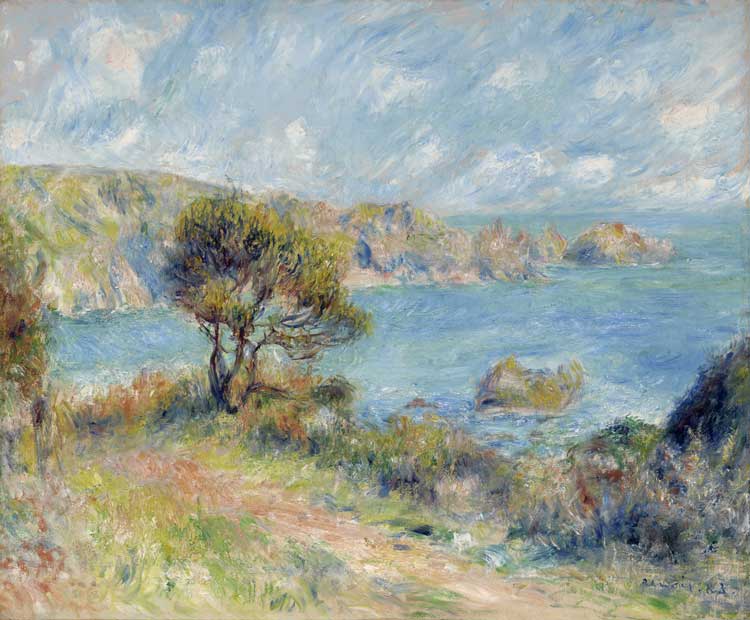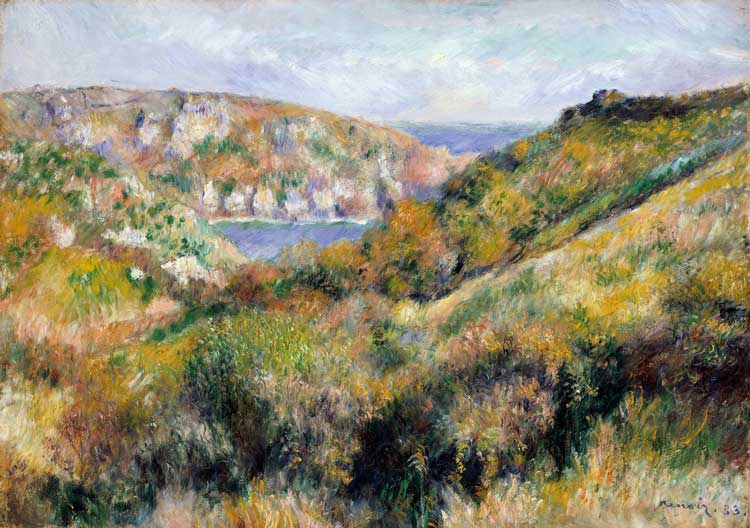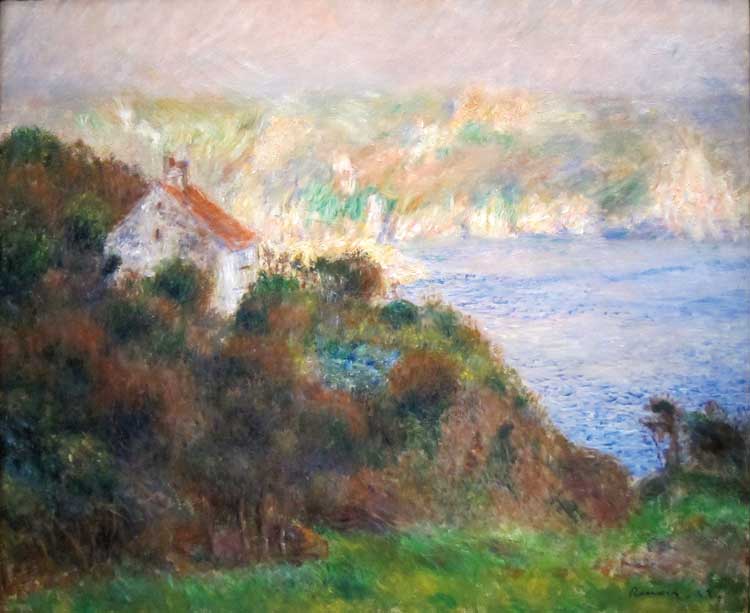,-Guernsey-JR.jpg)
Art for Guernsey's Renoir walk, Hills around the Bay of Moulin Huet, Guernsey. Photo: Juliet Rix.
Guernsey Museum, St Peter Port, Guernsey
30 September – 17 December 2023
by JULIET RIX
In 1883, Auguste Renoir (1841-1919) spent five weeks, from September to early October, on the Channel Island of Guernsey. He was, according to Cyrille Sciama, director of the Musée des Impressionnismes, Giverny, and co-creator of this exhibition, in an artistically dry period. Renoir had travelled to Italy in 1881 prompting a crisis of confidence. He is quoted by his friend, the art dealer Ambroise Vollard, as saying: “In around 1883, there was a break in my work. I had gone as far as I could with impressionism and I had reached the conclusion that I did not know how to paint or draw.”
This new exhibition makes the case for a re-evaluation of the importance of Renoir’s time in Guernsey, arguing that it was instrumental in bringing to an end this “break” and providing the artist with fresh inspiration and a way forward.

Pierre-Auguste Renoir, View at Guernsey, 1883, Oil on canvas, 18 1/8 x 21 15/16 in (46 x 55.7 cm). Clark Art Institute,
With 10 original Renoirs, eight of them loaned from across Europe and the US, the show is something of a coup for an island of just 62 sq km (24 sq miles) with a population of 64,000. It came about through the sheer determination of David Ummels, founder of Art for Guernsey, an NGO that primarily brings art to schoolchildren. He knew Renoir had painted at least 15 works on the island, and when one of them, an oil sketch that had remained in the artist’s possession until his death and then in private collections, came up for auction at Christie’s, he put together a syndicate to bid for it. They bought it for £443,000 (“I think we were lucky,” says Ummels) and it has since visited every year 3 class in Guernsey, before becoming the kernel of this exhibition.
.jpg)
Pierre-Auguste Renoir. Rochers de Guernesey avec personnages (plage à Guernesey) (Rocks in Guernsey with Figures, Beach in Guernsey), 1883. Oil on canvas, 18 ½ x 22 in (46.2 x 55.8 cm.).
The picture, Rochers de Guernesey avec Personnages, Plage à Guernesey (Rocks in Guernsey with Figures, Beach in Guernsey), is a colourful evocation of Moulin Huet Bay, Renoir’s favourite spot for painting on Guernsey. The bay is the subject of three other pictures in the exhibition, and of a specially shot video that unfortunately doesn’t do justice to the ever-changing light of this ruggedly beautiful stretch of coast.

Pierre-Auguste Renoir, Hills around the Bay of Moulin Huet, Guernsey, 1883. Oil on canvas, 18 1/8 x 25 3/4 in (46 x 65.4 cm).
It doesn’t matter because the unspoilt bay itself is just two miles away, sunlight still dancing over the surfaces of colourful rocks and rippling sea. Renoir himself said, “I like a painting which makes me want to stroll in it,” and Art for Guernsey has set up a Renoir walk highlighting five viewpoints around Moulin Huet from which the artist painted – an interesting and pleasurable adjunct to the gallery display.

Pierre-Auguste Renoir. Brouillard à Guernesey (Fog in Guernsey), 1883. Oil on canvas, 65.1 x 53.3 cm.
Here is the view captured in Brouillard à Guernesey, translated as Fog in Guernsey, although it is really more of a mist (Cincinnati Art Museum), which is part of the show. Looking from the garden of the newly reopened Renoir Tea Garden – a tearoom even in Renoir’s time – you can see how the artist took a touch of artistic licence in the angles, but the red-roofed cottage in the foreground of the painting is still here (mid-renovation) and the view of the bay is unchanged.
The exhibition curators note that this picture is similar to a painting by Claude Monet, La Maison du Pêcheur à Varangeville (Fisherman’s Cottage on the Cliffs at Varangeville), held by Boston Museum of Fine Arts, made in 1882, a year earlier than Renoir’s. Monet’s picture had been sold by Paul Durand-Ruel, the Paris art dealer the two artists shared. Renoir – who was neither rich nor especially famous at the time of his trip to Guernsey – may, Ummels suggests, have hoped it was a composition that would sell.

Pierre-Auguste Renoir. Enfants au bord de la mer à Guernesey (Children on the Seashore, Guernsey), 1883. Oil on canvas, 54.2 x 65 cm (21.3 x 25.5 in).
Several of Renoir’s pictures of Moulin Huet include bathers (and the spot remains popular with swimmers today). Among them is Art for Guernsey’s oil sketch, and (with a similar viewpoint) the more finished Enfants au Bord de la Mer, Guernesey (Children at the Seaside, Guernsey), which is not in the exhibition (its owner, the Barnes Collection, Philadelphia, does not lend) but features in the Renoir walk.
,-Moulin-Huet-Bay,-Guernsey---JR.jpg)
Art for Guernsey's Renoir walk, Enfants au bord de la mer à Guernesey (Children on the Seashore, Guernsey). Photo: Juliet Rix.
Renoir was surprised and delighted by Guernsey’s liberal attitude to bathing. Unlike in England and France at the time, here there were no bathing machines, no thick cover-all swimsuits or gender segregation. Guernsey islanders swam in skimpy costumes or sometimes nothing at all, changing unabashed among the rocks.
Renoir wrote to Durand-Ruel: “You cannot imagine how pretty it all looks, with women and men lying together on the rocks. It’s much more like being in a Watteau landscape than in reality. So, I’ll have a real source of graceful motifs that I will be able to use. Delightful bathing costumes and, as in Athens, women completely unafraid of the proximity of men on the neighbouring rocks.”
Here he connects the swimmers with those of Athens. He also linked Guernsey’s naked bathers with the classical and Renaissance nudes he had seen on a recent trip to Italy. This exhibition argues that Renoir’s time in Guernsey led his synthesising of these influences in a series of paintings begun soon after he returned to Paris, of idealised but modern nude female bathers in realistic landscapes. This show includes an example in Baigneuse Assise sur un Rocher (Bather Seated on a Rock) (c1883, Musée Marmottan Monet, Paris), although the influence of Guernsey’s landscape is clearer in Baigneuse Assise (The Seated Bather) (c1883-4, Harvard Art Museum) where the background could easily be inspired by Moulin Huet Bay.
.jpg)
Pierre-Auguste Renoir. Baie de Salerne (Bay of Salerno), 1881.
A couple of the paintings in the show have no connection to Guernsey – or rather, that was the case when they arrived on the island. In one case that may have changed. When a member of the museum staff was unpacking the picture, she commented that the date was wrong. It was marked 1881. Then she spotted the title: Baie de Salerne (Bay of Salerno). She protested that it wasn’t Italy but Guernsey. She had immediately recognised it as a view along the coast in front of the capital St Peter Port, complete with its castle and lighthouse.

View along the coast in front of the capital St Peter Port, Guernsey, 2023.
At the opening of the exhibition, I ask a local where this scene might be on Guernsey and (knowing nothing of the story), he immediately identifies it as the same place. Ummels then produces a convincing photo of the scene today. Art for Guernsey is now speaking to the lender (MuMa, Le Havre) and further research will now follow.
Perhaps this little exhibition will result in more of a reassessment of Renoir’s time work on Guernsey than even its curators expected.